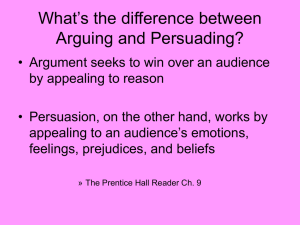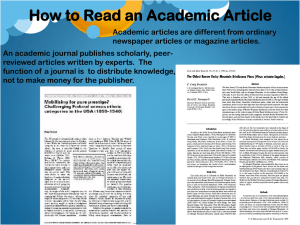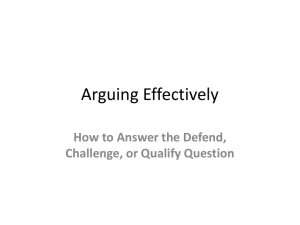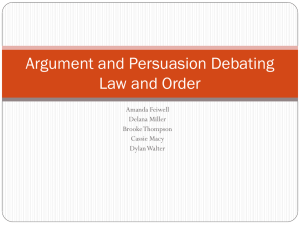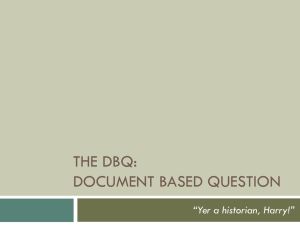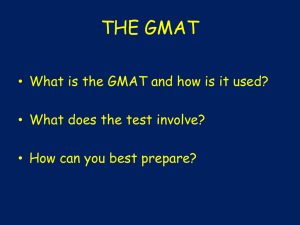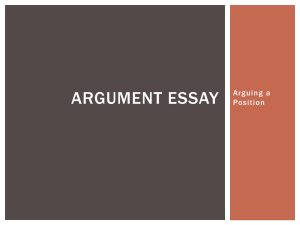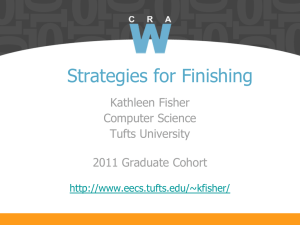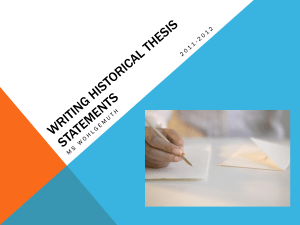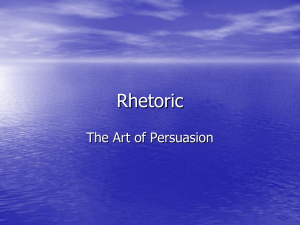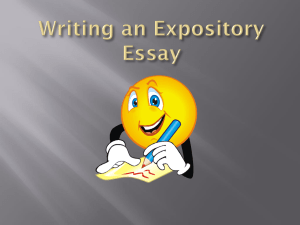APUSH Exam breakdown
advertisement
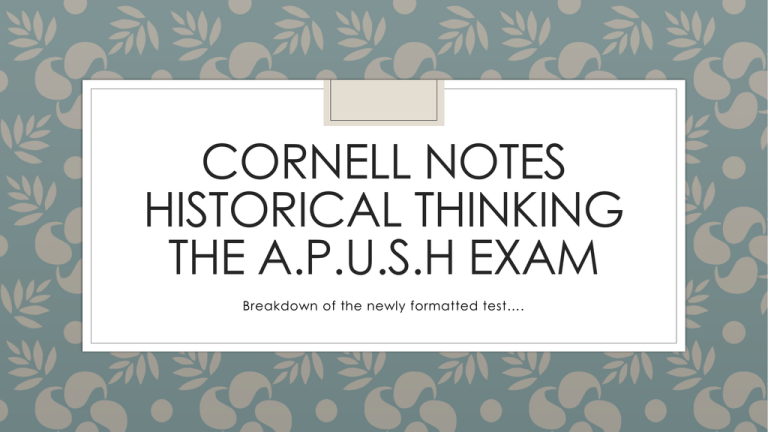
CORNELL NOTES HISTORICAL THINKING THE A.P.U.S.H EXAM Breakdown of the newly formatted test…. Cornell Notes 2 ½” 6” Cue Column Note-taking Column 1. Record: use the note taking column to write down relevant/ important data. Use this column to add notes from my lecture to notes from your reading. 2. Questions: After your readings/ lectures formulate questions. Writing questions helps to clarify meanings, reveal relationships, establish continuity, and strengthen memory. Also, writing questions sets up a perfect state for exam-studying later. 3. Recite: Cover note taking column with a sheet of paper. Then looking at the questions or cue-words in the question and cue column only, say aloud, in your own words, the answers to the questions, facts or ideas indicated by the cue-words. 4. Reflect: Reflect on the material by asking yourself questions, for example: “What’s the significance of these facts? What principle are they based on? How can I apply them? How do they fit in with what I already know? What’s beyond them? 5. Review: Spend at least 10 minutes every week reviewing all your previous notes. If you do, you’ll retain a great deal for current use, as well as , for the exam. 2” Summary Use this space on the bottom of the page to summarize notes on this page (using your own words)… If you can restate what we’ve covered/ what you’ve read, you know the content. Historical Thinking Skills Skill Type Historical Thinking Skill I. Chronological Reasoning 1. Historical causation 2. Patters of continuity and change over time 3. Periodization II. Comparison and Contextualization 4. Comparison 5. Contextualization III. Crafting historical arguments from historical evidence 6. Historical argumentation 7. Appropriate use of relevant historical evidence IV. Historical interpretation and synthesis 8. Interpretation 9. Synthesis Thematic Learning Objectives ◦ Identity ◦ ID; How and why have debated over American national identity changed over time? ◦ How have gender, class, religious, and other group identities changed in different eras? ◦ In other words- demonstrate understanding of ways that debated over national identity have changed over time. ◦ Work, Exchange and Technology ◦ WXT How have changed in markets, transportation, and technology affected American society from colonial times to present day? ◦ Why/ how different systems developed in British N. America & the U.S have affected U.S society. ◦ How have the debates over economic values & the role of government in the U.S economy affected politics, society, the economy, & environment? ◦ Demonstrate understanding of ways that changes in markets, transportation, and technology have affected U.S society. ◦ Peopling ◦ PEO Why have people migrated to, from and within N. America? ◦ How have changes in migration & population patterns affected American life. ◦ Politics and Power ◦ POL Demonstrate understanding on how and why different political & social groups competed for influence over society & government in what would become the U.S AND how Americans agreed/ argued over the values that guide political systems as well as who is part of the political process. ◦ America in the World ◦ WOR Demonstrate understanding of the relationship among events in the U.S and contemporary events in the rest of the world –AND- how different factors influenced U.S military, diplomatic, and economic involvement in international affairs & foreign conflicts. ◦ Environment and Geography (Physical and Human) ◦ ENV Demonstrate understanding of the various ways in which interactions with the natural environment shaped the institutions & values of various groups living in the U.S ◦ Ideas, Beliefs and Culture ◦ CUL Demonstrate understanding of how and why moral, philosophical, and cultural values changed and have affected U.S history Historical Periods ◦ 1. 1491-1607 ◦ 2. 1607-1754 ◦ 3. 1754-1800 ◦ 4. 1800-1848 ◦ 5. 1844-1877 ◦ 6. 1865-1898 ◦ 7.1890-1945 ◦ 8. 1945-1980 ◦ 9. 1980- present Exam Description ◦ The A.P.U.S.H Exam is 3 hours and 15 minutes long- divided into 2 sections ◦ 100-minutes for MC/ short-answer (S.A) sections AND ◦ 95- minutes for free-response section- Long Essay Question (LEQ) & Document Based Question (DBQ) ◦ Each Section is divided into 2 parts: Section Question Type # of Questions I Part A: MC Questions 55 questions 55 minutes 40 % Part B: S.A Questions 4 questions 45 minutes* 20% Part A: DBQ 1 question 60 minutes 25% Part B: LEQ 1 question (chosen 35 minutes 15% II from a pair) Timing % of Total Exam Score * Each S.A question (total 4) has 3 parts (part A, B & C). So, keep in mind that (in essence) you are really answering 12 different questions. You should dedicate no more than 3 minutes per each part of the questions. Time Management ◦ You will need to learn to budget your time. ◦ Especially critical for Section II 2 essays, time left is unannounced, not forced to move to the next question. ◦ You will benefit from taking the required/ mandatory practice exam on May 2nd. How Learning is Assessed on AP Exam: ◦ Achievement of the thematic learning objectives ◦ Use of historical thinking skills (i.e. - subjective analysis) ◦ Understanding of all nine periods of U.S History (on your syllabus) ◦ Note: No DBQ or Essay will focus exclusively on events prior to 1607 (Period 1) or after 1980 (Period 9) ◦ You will write at least one essay (DBQ or LEQ) that examines long-term developments that span historical time periods. Multiple Choice Questions ◦ A number of questions; 2-5 questions per set. ◦ You will be responding to stimulus material (documents; political cartoons, speeches, newspaper clippings, etc…) ◦ Stimulus material will reflect the types of evidence that historians use in their research. ◦ A set may focus on one particular periods of U.S history. ◦ Individual questions within that set may ask to make connections to thematically linked developments in other periods CAUSATION! Change over time. ◦ Will assess ability to reason about the stimulus material in tandem with knowledge of historical issue at hand. ◦ Questions will reflect the level of detail present in required historical developments. Short-Answer Questions (S.A.) ◦ Will directly address one or more of the thematic learning objectives for the course. ◦ AT LEAST two of the four questions will have elements of internal choice will provide opportunities for you to demonstrate what you know best. ◦ ALL S.A. questions will require historical thinking skills in order to respond to a primary source, a historian’s argument, non-textual sources such as data or maps or general propositions about U.S history. ◦ Each question will ask you to identify and analyze examples of historical evidence relevant to the source or question. Document-Based Question ◦ Measures ability to analyze and synthesize historical data and to assess verbal, quantitative, or visual materials as historical evidence. ◦ Responses will be judged on ability to formulate thesis and support it with relevant evidence. ◦ Documents included in DBQ or not confined to a single format; many vary in length, and are chosen to illustrate interactions and complexities within the material. ◦ Documents will include charts, graphs, cartoons and pictures as well as written material. ◦ Will require you to relate the documents to a historical period or theme and, thus, to focus on major periods and issues. ◦ Always important to include outside knowledge beyond the specific point of the question. ◦ Use all but 1 of the documents. Long Essay Question (LEQ) ◦ Provides opportunity to demonstrate what you know best. ◦ Choice will be given between two comparable LEQ options. ◦ Measures the use of historical thinking skills to explain and analyze significant issues in U.S history. ◦ Must include the development of a THESIS or argument supported by an analysis of specific, relevant historical evidence. ◦ Questions will be framed to allow you to answer in-depth examples of large scale phenomena (may be drawn from topics discussed in our class) Sample of a M.C Question: ◦ “Still, though a slaveholder, I freely acknowledge my obligations as a man; and I am bound to treat humanely the fellow creatures whom God has entrusted to my charge. … It is certainly in the interest of all, and I am convinced it is the desire of every one of us, to treat our slaves with proper kindness.” – Letter from former South Carolina governor James Henry Hammond, 1845 ◦ “Standing with God & the crushed & bleeding slave on this occasion, I will, in the name of humanity which is outraged, in the name of Liberty which fettered, in the name of constitution and Bible, which are disregarded and trampled upon, dare to call in question and denounce … slavery ‘the great sin and shame of America’!” – Frederick Douglas, speech titles “The Meaning of July Fourth for the Negro, “ 1852 ◦ 4. The excerpt from James Henry Hammond is most clearly an example of which of the following developments in the mid-19th century? ◦ A. The decline of slavery in Southern states as a result of gradual emancipation laws. ◦ B. The increasingly restrictive nature of slavery in the South enforced by stronger slave codes. ◦ C. The expanding use of moral arguments by Northern antislavery activists ◦ D. The growing tendency among Southern slaveholders to justify slavery as a positive good. ◦ 5. Which of the flowing groups would be most likely to support the perspective of Frederick Douglas in the excerpt? ◦ A. Southern Democrats ◦ B. Southern Planters ◦ C. Northern Abolitionists ◦ D. Northern Merchants SAMPLE of a S.A. Question,(type 1): ◦ A. Briefly explain why ONE of the following options most clearly marks the beginning of the sectional crisis that led to the outbreak of the Civil War. ◦ Northwest Ordinance (1787) ◦ Missouri Compromise (1820) ◦ Acquisition of Mexican territory (1848) ◦ B. Provide an example of an event or development to support your explanation. ◦ C. Briefly explain why one of the other options is not as useful to mark the beginning of the sectional crisis. SAMPLE of a S.A Question, (type 2) Using the image “above”, answer a, b, and c. A.Briefly explain the point of view about the economy expressed by the artist. B. Briefly explain ONE development in the period of 1865 to 1910 that could be used to support the point of view expressed by the artist. C.Briefly explain ONE development in the period of 1865 to 1910 that could be used to challenge the point of view expressed by the artist. Same of DBQ (docs not included) ◦ Directions: Question 1 is based on the accompanying documents. The docs have been edited for the purpose of this exercise. You are advised to spend 15 minutes planning & 45 minutes writing your answer. Write your responses on the lined pages that follow the questions. ◦ Your response should do the following: State relevant thesis that directly addresses all parts of the question, Support the thesis or a relevant argument with evidence from all (or all but one) of the docs, Incorporate analysis of all, or all but one, of the docs in your argument, Focus your analysis of each doc on at least one of the following: intended audience, historical context, and/ or point of view, Support you argument with analysis of historical examples outside the docs, Connect historical phenomena relevant to your argument to broader events or processes, Synthesize the elements above into a persuasive essay. ◦ Question 1: Analyze major changes and continuities in the social and economic experiences of African Americans who migrated from the rural South to urban areas in the North in period 1910-1930. DBQ Rubric. Max Points: 7 ◦ A. Thesis: 0-1 Point Skills assessed: Argumentation + targeted skill States a thesis that directly address ALL parts of the question. Must do more than restate the question. *Note: if thesis only address part of a prompt = 0 points. ◦ B. Analysis of historical evidence and support of argument: 0-4 points ◦ Skills assessed: Use of evidence, argumentation, & targeted skill (comparison) Analysis of documents (0-3 points) I POINT: Offers plausible analysis of the content of a MAJORITY of the documents, explicitly using this analysis to support the stated these or a relevant argument. or 2 PTS: Offers plausible analysis of BOTH content of a majority of the docs, explicitly using this analysis to support the stated thesis or a relevant argument. -ANDAt least 1 of the following for the majority of docs: *Intended audience *Purpose *Historical context and/ or *authors point of view or 3 PTS: Offers plausible analysis of BOTH the content of all or all but one of the docs, explicitly using this analysis to support the stated thesis or a relevant argument. -ANDAt least 1 of the following or all or all but of the docs: *Intended audience *Purpose *Historical context and/ or *authors point of view DBQ Rubric (Continued)… -AND/ ORAnalysis of outside examples to support thesis/ argument (0-1 point) 1 PT: Offers plausible analysis of historical examples beyond/ outside the doc to support the stated thesis or a relevant argument. C. Contextualization: 0-1 point 1 PT: Accurately and explicitly connects historical phenomena relevant to the argument to broader historical events and/ or processes. D. Synthesis: 0-1 point Respond synthesizes the argument, evidence, analysis of docs, and context into a coherent & persuasive essay by accomplishing 1 or more of the following as relevant to the question: 1 PT: Appropriately extends or modifies the stated thesis or argument. or 1 PT: Recognizes and effectively accounts for disparate, sometimes contradictory evidence from primary sources and/ or secondary works in crafting a coherent argument. or 1 PT: Appropriately connects the topic of the question to other historical periods, geographical areas, contexts of circumstances. LEQ Rubric. Max Points: 7 ◦ A. Thesis: 0-1 point. (skills assessed: argumentation) ◦ I PT: States a thesis that directly address all parts of the question. The thesis must do more than restate the question. No points awarded of only addresses part of the prompt. ◦ B. Support for argument: 0-2 points (skills assessed: argumentation, Use of evidence) 1 PT: Supports the stated thesis (or makes a relevant argument) using specific evidence OR 2 PTS: Supports the stated thesis (or makes a relevant argument) using specific evidence, clearly & consistently stating how the evidence supports the thesis or argument, and establishing clear linkages between the evidence and the thesis or argument. ◦ C. Application of targeted historical thinking skill: 0-2 points. (skills assessed: Targeted skill) For questions assessing CONTINUITY & CHANGE OVER TIME (C-COT) 1 PT: Describes historical continuity AND change over time. OR 2 PTS: Describes historical continuity AND change over time, and analyzes specific examples that illustrate historical continuity AND change over time. LEQ Rubric- Continued ◦ C. (Continued) For questions assessing COMPARISON 1 PT: Describes similarities AND differences among historical developments Or 2 PT: Describes similarities AND differences among historical developments, providing specific examples -ANDAnalyzes the reasons for their similarities AND/ OR differences –ORDEPENDING ON THE PROMPT, evaluates the relative significance of the historical developments. For questions assessing CAUSATION For questions assessing PERIODIZATION 1 PT: Describes causes AND/ Or effects of a historical development I PT: Describes ways in which the historical development specified in the prompt was different from OR similar to developments that preceded and/ or followed. 2 PT: Analyzes the extent to which the historical development specified in the prompt was different from AND similar to developments that preceded and/ or followed, providing specific examples to illustrate analysis. 2 PT: Describes causes AND/ OR effects of a historical development and analyzes specific examples that illustrate causes AND/ OR effects of a historical development LEQ Rubric (Continued)… ◦ D. Synthesis 0-1 point (skill assessed: Synthesis) Response synthesizes the argument, evidence, and context into a coherent and persuasive essay by accomplishing one or more of the following as relevant to the question. 1 PT: Appropriately extends or modifies the stated thesis or argument. or 1 PT: Explicitly employs an additional appropriate category of analysis (e.g., political, economic, social, cultural, geographical, race/ ethnicity, gender) beyond that called for in the prompt. or 1 PT: The argument appropriately connects the topic of question to other historical periods, geographical areas, contexts or circumstances. Q&A
